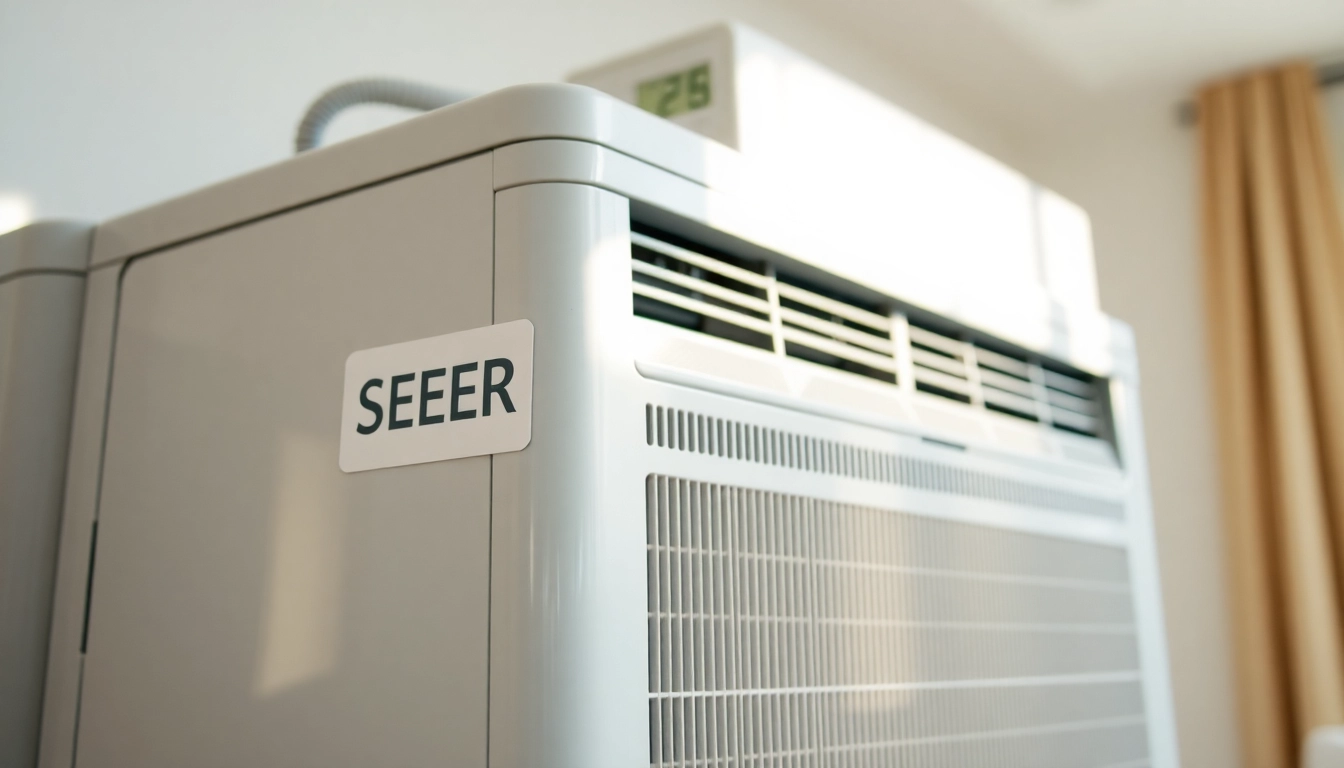What is SEER in Air Conditioning?
When it comes to air conditioning, understanding efficiency ratings is crucial for any homeowner or business owner looking to minimize energy costs while maximizing comfort. One of the key terms that emerges in this discussion is SEER, which stands for Seasonal Energy Efficiency Ratio. This metric provides a measure of how efficiently an air conditioning system operates. In this article, we will explore the concept of SEER in depth, explain its importance, compare different SEER ratings, and provide guidelines on choosing the right SEER rating for your air conditioning unit.
The Definition of SEER
SEER is a critical performance metric used to measure the cooling efficiency of air conditioning systems over an entire cooling season. Specifically, it quantifies the total cooling output of an air conditioning unit (measured in British Thermal Units, or BTUs) divided by the total electrical energy input (measured in watt-hours) required to operate the unit during that same period. The formula can be represented as:
SEER = Total BTU cooling output during the cooling season / Total watt-hours consumed during the cooling season
A higher SEER rating indicates a more efficient unit, meaning it uses less energy to provide the same amount of cooling compared to a unit with a lower SEER rating. It is important to note that the SEER rating is calculated based on standardized testing conditions, ensuring a level playing field when comparing different systems.
How is SEER Calculated?
The calculation of SEER is performed under controlled conditions that simulate a typical cooling season. This means that manufacturers test their air conditioning units across various outdoor temperatures, humidity levels, and operational scenarios. The process includes:
- Cooling Output Measurement: The BTUs produced by the air conditioning system are measured throughout the cooling season.
- Energy Consumption Measurement: The total electrical energy consumed during that season is recorded in watt-hours.
These two metrics are then used to calculate the SEER rating, providing consumers with a clear understanding of how efficiently a unit will perform in real-world conditions. For instance, a unit with a SEER rating of 16 will produce 16 BTUs of cooling for every watt-hour of electrical energy consumed.
Where to Find SEER Ratings
SEER ratings for air conditioning units are typically displayed on the unit’s EnergyGuide label, which is usually located on the side or back of the unit. Additionally, SEER ratings can be found in the product specifications provided by the manufacturer in their catalogs or on their websites. It’s essential for consumers to check these ratings before purchasing a new air conditioning system to make informed choices regarding energy efficiency.
The Importance of SEER Ratings
Why SEER Matters for Homeowners
Understanding SEER ratings is crucial for homeowners for several reasons. First and foremost, a higher SEER rating translates into lower energy bills. With rising costs of electricity, selecting an energy-efficient air conditioning unit can lead to considerable savings over time. Additionally, higher SEER units are often better for the environment, as they reduce overall energy consumption and, in turn, decrease greenhouse gas emissions. Therefore, being informed about SEER ratings empowers homeowners to make choices that positively impact their finances and the planet.
Impact on Energy Costs
The impact of SEER ratings on energy costs can be significant. For instance, a unit with a SEER rating of 14 may use around 14% more energy than a unit with a 16 SEER rating to provide the same cooling capacity. According to energy savings calculators, upgrading from a 14 SEER to a 16 SEER unit can lead to approximately 13% less energy usage for the same cooling demands. This connection between SEER ratings and energy costs underlines the importance of investing in an air conditioning system with a higher SEER rating.
Environmental Considerations
From an environmental standpoint, energy-efficient systems with high SEER ratings use less electricity, thus decreasing the demand from power plants and subsequently reducing carbon emissions associated with energy production. By investing in higher efficiency systems, homeowners contribute to a more sustainable future while also gaining financial benefits. Choosing air conditioning units with elevated SEER ratings aligns well with eco-friendly practices, making it a wise decision for environmentally conscious consumers.
Comparing SEER Ratings
How Different SEER Ratings Affect Efficiency
Comparing different SEER ratings can help buyers understand how efficiency impacts performance and energy costs. For residential units, SEER ratings typically range from 14 to 25. Here’s how different SEER levels affect efficiency:
- 14-16 SEER: These units are considered basic energy-efficient models suitable for most homes. They offer a balance of performance and affordability for consumers.
- 16-20 SEER: Mid-range efficiency models fall into this category. They provide better energy savings and are excellent options for homeowners looking to reduce long-term energy costs.
- 20+ SEER: High-efficiency models are best for those seeking maximum energy savings and performance. Though the upfront investment is higher, the return on investment through reduced energy bills can be substantial.
This breakdown illustrates the clear gradation of both performance and efficiency as SEER ratings increase, providing consumers with essential information to make informed purchase decisions.
14 SEER vs. 16 SEER: Is It Worth It?
The difference between a 14 SEER and a 16 SEER air conditioning unit can be viewed in multiple contexts. While the difference of two points in SEER rating may seem marginal, the real-world implications can lead to significant cost savings. Here is a comparative analysis:
- Annual Costs: A 16 SEER air conditioning unit typically costs about 13% less to operate compared to a 14 SEER unit, translating into annual savings on energy bills.
- Initial Investment: The initial cost of purchasing a 16 SEER unit can be higher, but the savings on energy costs often recoup that expense over time.
- Comfort Levels: Higher SEER units can provide more consistent cooling, enhancing overall indoor comfort.
Homeowners must weigh these factors against their budgetary constraints to decide if upgrading to a 16 SEER system is worth the investment. For many, the long-term savings and improved comfort warrant the additional cost.
The Shift to SEER2 Ratings
In recent years, the HVAC industry has seen a shift from traditional SEER ratings to SEER2 ratings, which are meant to provide a more accurate representation of unit efficiency in actual operating conditions. SEER2 accounts for the energy consumption of units in real-world environments, considering factors such as airflow rates and temperatures. Understanding the differences is crucial for homeowners when selecting new air conditioning systems, as SEER2 ratings will likely become the standard in the coming years.
Choosing the Right SEER Rating for Your AC
Factors to Consider When Buying
When purchasing a new air conditioning unit, several factors should influence your choice of SEER rating:
- Climate: Homeowners living in hotter climates will benefit more from high SEER ratings, as these units can provide significant energy savings during prolonged cooling seasons.
- Home Size: Larger homes may require units with higher SEER ratings for efficient cooling, whereas smaller spaces might operate adequately with lower ratings.
- Budget: The initial investment must be balanced with long-term energy savings. Consider your budget for both upfront costs and operational expenses.
- Local Regulations: Be aware of local energy efficiency regulations, as certain regions may mandate specific SEER ratings for new installations.
Taking these elements into account will help you select the most suitable air conditioning system for your specific needs and circumstances.
Common Misconceptions about SEER
There are several misconceptions surrounding SEER ratings that can lead to confusion among consumers:
- Higher SEER Always Equals Better: While generally true, the “right” SEER rating depends on your unique needs and local climate conditions.
- SEER Ratings are Absolute Measures: SEER ratings are based on standardized testing and may not always reflect real-world efficiency, especially in varying environmental factors.
- Higher Initial Costs Mean Higher Savings: It’s essential to evaluate the total cost of ownership, including installation costs and annual energy bills, rather than focusing solely on initial expenses.
Understanding these misconceptions can help buyers make informed decisions when purchasing new cooling systems.
Expert Recommendations on SEER Levels
Industry experts generally recommend a few guidelines when selecting SEER ratings for air conditioning units:
- Minimum Standard: Opt for a unit with at least a 14 SEER rating to ensure basic energy efficiency.
- Mid-Range Recommendation: For most homeowners, a 16 SEER rating offers an optimal balance of cost and efficiency.
- Premium Efficiency: In extremely hot climates or larger homes, consider units with SEER ratings of 20 or above for maximum savings and performance.
Following these recommendations can help ensure that homeowners not only stay comfortable but also keep their energy costs manageable.
Maintenance Tips for High SEER Units
Ensuring Optimal Performance
Maintaining high SEER air conditioning units is critical for ensuring their efficiency and longevity. Here are some best practices for maintenance:
- Regular Filter Changes: Keep air filters clean and replace them every 1-3 months to ensure optimal airflow and efficiency.
- Annual Professional Maintenance: Schedule yearly check-ups with a certified HVAC technician to ensure the system operates correctly and efficiently.
- Keep the Area Around the Unit Clear: Ensure that debris and vegetation do not obstruct airflow around the outdoor unit.
These steps can help maintain energy efficiency and prolong the life of high SEER air conditioning units.
Signs Your SEER Unit Needs Attention
Be vigilant for signs that your air conditioning unit may need servicing:
- Increased Energy Bills: A sudden spike in energy costs could signify inefficient operation.
- Inconsistent Temperatures: If some rooms are warmer or cooler than others, your unit may not be performing optimally.
- Unusual Noises: Sounds like clattering or grinding can indicate mechanical issues that need prompt attention.
Identifying these issues early can help prevent more significant problems and costly repairs down the road.
Long-Term Care for Efficient Cooling
To ensure the continued efficiency of high SEER air conditioning systems, consider implementing the following practices:
- Utilize Smart Thermostats: These devices optimize indoor temperatures and minimize unnecessary energy usage.
- Monitor Usage Patterns: Adjust settings based on usage patterns to prevent overcooling and reduce energy costs.
- Educate Household Members: Ensure all family members understand how to use the system efficiently, including ideal thermostat settings and when to turn the system off.
With these strategies, homeowners can significantly enhance the performance and efficiency of their air conditioning systems over the long term.




